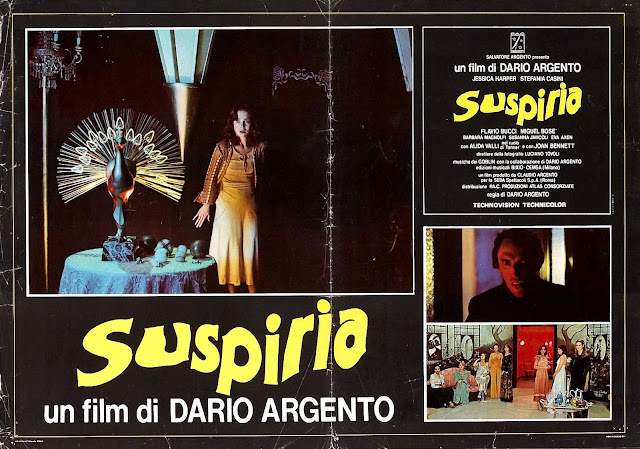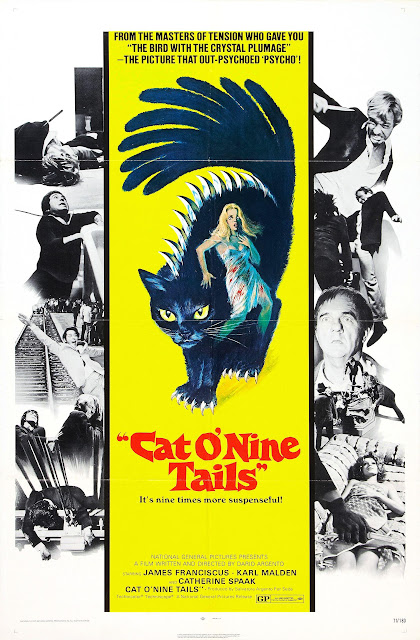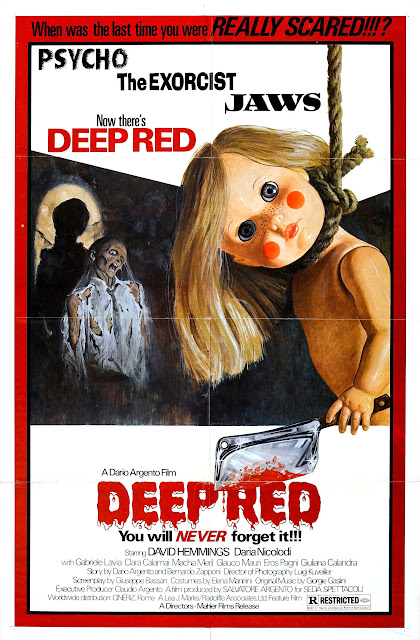Dario Argento
Suspiria in a Swimming Pool
The Russian synchronised swimmers just did their routine to Goblin’s creepy and wonderful score to Dario Argento’s Suspiria!
Amazing.
(video via AVClub)
Suspiria

SUSSSSSSSSPIRIA! On a great big screen!
Last night, after a week of Argento film’s, I got to see his spellbinding masterpiece Suspiria on a cinema-screen in the National Media Museum as part of the Bradford International Film Festival. I’d obviously wound myself into a bit of a frenzied excitement about it through the week and it certainly did not disappoint.
Every time I hear someone say they choose to watch films at home rather than at the cinema, mostly due to all the other film-goers, I think to myself “You’ve just been going to the wrong films with the wrong people!”. Last night’s audience had almost all seen the film before and sat in captivated silence, tittering nervously at the occasional gentle comic moments and - even before fun - audibly anticipating oncoming moments of horror. If a bad crowd can ruin a film, a great crowd can make one. Not that Suspiria needed any help in that respect…
My first and only minor gripe is that it was very sadly the cut version. This was an original cinematic print taken from the Media Museum’s extensive archive and so was a print of the X-rated version that the BBFC approved in 1977, after demanding 1m13 of cuts (Cut info at Melon Farmers). Now, to those not familiar with horror film, particularly of BBFC-butchered horror film of a couple of decades ago, 1m13 might not sound very much. It also might not sound so important if I tell you that the full extent of the cuts involved removing a series of close-ups of stabbing, someone struggling through barbed wire and a dog biting a man’s throat. Cuts, however, do make a difference to the rhythm and pacing of a film. Suspira is a film that, like so many Argento, thrives on the atmospheric build-up, to the point that the death scenes actually become a kind of release. For a couple of them to be dramatically shortened here was a shame.
Still, whilst that was the downside to it being an original theatrical print, there were certainly upsides. The first (and some would reject this) was that the image did have a wonderfully scratchy look. Anyone who’s seen a film in cinemas that was filmed entirely in HD-digital knows how clinical and sterile it can look (I’m looking at you Public Enemy!) and, whilst I’m not suggesting scratchy is the way forward, there was certainly something enjoyable about watching a 70s film I thought I’d never see in a cinema, complete with all the visual wear and tear that a 30 year old 35mm reel has experienced (even if carefully looked after by the Museum)
The second benefit was the sound. The sound! Anyone who’s seen Suspiria, an Argento film or evne read any of my blog from this week will know that sound makes up an enormous part of Argento’s films. Suspiria is (arguably) the very best of these, scored again by the ever wonderful Goblin, and positively throbs, jangles and crashes at you. Original print, combined with cinema sound system made it an utterly fantastic experience that I’m sure I’ll never be able to repeat (especially as most commercial releases saw the soundtrack savagely remixed).
The film itself is a whirling, semi-nonsensical, breathtaking journey of colour and sound, moving from the giallo murder-mystery into something a whole lot more supernatural, with savagely brilliant results. I really don’t want to say too much more about the actual film, save to say that it is pretty much the best example of all the techniques I’ve been seeing this week in all his other films. It’s not perfect (the scene-with-the-bat is awful) but it’s brilliant, beautiful and should be seen by everyone.
Argento Week's FINALE!

Of course, all that Dario Argento film watching wasn’t just for fun, it was all to build up to the fantastically exciting screening of Suspiria tonight in the Bradford International Film Festival. It’s hardly going to be worth me reviewing it - I love the film so much already a review will probably be just a string of superlatives and smiley faces - but I’m hoping that, given the big screen treatment, I’ll find even more to love about it!
Cat O' Nine Tails

So here we are! Last night’s film, which was number 7 and brought my week of Argento films (before Suspiria tonight) to a close, was Cat O’ Nine Tails, another one that I hadn’t seen before. I was, I must say, pleasantly surprised. It falls, again, into the giallo camp more than the horror side - although they all show elements of both - and, being another very early film I must admit I didn’t expect as much fun as I got.
Several online reviews - especially those from Argento fans - are really quite negative about this film, describing it as a fairly ham-fisted follow up to Bird with the Crystal Plumage, but I couldn’t agree less. The story telling here was tight and interesting, the dialogue was er… no more clunky than we might expect and the characters and motivations were interesting.
Having watched it the day after watching Profondo Rosso, it was all too easy to see this as a blueprint for the later, more superior murder thriller; many of the aspects that were to become Argento staples are still in nascent form here. The camera is subjective and active but… not as intelligently so as in later films (some of the camera angles here seem less surprisingly wonderful and more just ‘different’), the music is absolutely instrumental (no pun intended…) in the creation of a dens atmosphere but never quite matches the iconic heights of later films - it definitely isn’t particularly memorable - the plot is full of red-herrings and hidden clues but the denouement is nowhere near as satisfying as later Argento, particularly Profondo Rosso.
It would be certainly true to call this one of the least “Argento-esque” Argento film but that’s not necessarily a bad point. I’d suggest that the film stands up pretty well on its own merits and, if the ending is perhaps a little rushed, is definitely an enjoyable watch. It’s a film that’s perhaps best recommended to those who aren’t as keen on the more flamboyantly visuals of the later films, or to those keen to see where those visuals came from. It’s certainly not perfect but it’s far from the weak slasher I had been lead to expect.
Profondo Rosso [aka Deep Red]

Well, after the (comparatively) low point of Four Flies…, the week got right back on track with the superb Argento masterpiece that is Profondo Rosso. This is a film very much in the Bird with the Crystal Plumage vein; it’s giallo murder mystery through and through. On top of that, it’s done extremely well.
Here, more than anywhere, I’ll have to tread very carefully in not giving away spoilers. Deep Red, you see, has a more carefully constructed plot than most Argento films and, as well as not knowing to the very end who’s responsible, we actually care! It’s a film that is more perfectly balanced than his other movies. Phenomena, for all that it was a great watch, has a very long period of almost-nothing-happening through the middle (although the awesomeness of the end makes this easy to forgive!), but Profondo Rosso is a much more polished piece. Information is given away little by little, red herrings and genuine clues are tumbled together into a mix that is never less than enthralling (Enthralling seems a little too fancy a word, but I’m aware that I’ve called nearly every Argento film this week ‘compelling’…). And never fear, the end certainly lives up to the standard set by the rest of the film!
On top of a much more involving plot, the film retains all the other Argento staples, all feeding into the near perfect mix. The Goblin theme tune is piercing synth-perfection, creeping gently into a previously silent scene as the camera bobs and weaves. Like all the best Argento moments, the atmosphere here is tense and threatening. You only need to hear the bass-line fading in as the camera slides slowly across the scene and your heartbeat rises.
This is, as I have said repeatedly already this week, an experience more than a narrative (even if the narrative is stronger here!). Argento films play to the senses, appeal to the nerves, excite your pulse and quicken your breath. To an extent, these work best if you can disengage your brain slightly: we tend to watch films with a keen critical eye, removing ourselves emotionally in order to pass sterile judgements on acting quality, narrative etc. Forget that. Don’t analyse an Argento film, watch an Argento film. The hardest part of writing about these films is remembering the finer details of the films; I know I had a thoroughly enjoyable two hours, that I was shocked at times, tense at times, laughing at times (Gianna’s knackered car provides welcome comic release).
Profondo Rosso is an excellent film, a fantastic journey and a great starting place for anyone who hasn’t seen an Argento film. It’s perhaps not my favourite - I lean toward the psychological horror rather than the murder mystery - but it’s a great film to watch.
Excellent theme tune: